Plasterboard ceiling in the hallway: pros, cons and an overview of the varieties
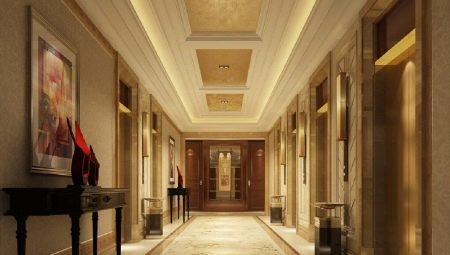
The ceiling is often an independent design element and organically fits into the artistic image of the room. Modern manufacturers offer a huge amount of materials for decorating ceilings, the most popular of which is considered to be drywall.

Advantages and disadvantages
The first room a person enters into when entering a house is the hallway or corridor, which can be called the hallmark of the living space. Depending on their condition and decoration, a general impression of the apartment and its owners is formed. A plasterboard ceiling can be called the optimal solution when decorating a space, since this material allows you to quickly and inexpensively give a room a unique look. High consumer demand for plasterboard ceilings is due to a number of advantages that distinguish these practical structures from structures made of other materials.
- Suspended plasterboard ceiling perfectly mask defects and irregularities in ceilings and makes the surface perfectly flat. This is especially valuable when decorating premises in old wooden houses, where ceilings crack over time, and even in the middle there is often a floor beam.
- Due to the low weight of the gypsum board, the ceiling structure turns out to be very light and does not exert a tangible load on the floors. So, one square of the area of the plasterboard ceiling weighs no more than 10 kg, including the metal profile and fasteners. For example, even a 10 mm layer of plaster of the same area weighs much more.
- Drywall is so simple and flexible in processing that the construction of the ceiling structure can be done independently, while you need to start with single-level structures. It is better to postpone ceilings of a more complex configuration for later, and gain experience with simple options.
- If you have the necessary components, the installation of a plasterboard ceiling will not take much time. Professional craftsmen are able to assemble the frame during the day, sheathe it with drywall and putty. In the absence of experience, it can take 2-3 days to install the ceiling, which is also a short time for such large-scale works.
- Low cost of gypsum board allows you to significantly save on repairing the hallway, while obtaining a stylish and practical ceiling.
- Due to the presence of a frame, there is always a small space between the sheets of gypsum board and the ceiling.... This allows you to hide communications there, which eliminates the need to gouge the concrete surface.
- Drywall is absolutely safe for humans and can be used in residential areas. Its environmental friendliness is due to its composition, in which, in addition to plaster and ordinary paper, there is nothing else. The main thing is to use the same harmless materials as drywall itself as a topcoat, and purchase only certified putties.
- And since plasterboard ceilings are fireproof, then any light sources can be mounted in themwithout fear of surface overheating and ignition. For comparison, on ceilings made of PVC, incandescent lamps with a power of no more than 60 W can be installed, and halogen lamps with a power of no more than 35 W.
- Drywall cuts and bends very well, which allows you to give it any shape, embodying the most daring design decisions.




True, the gypsum plasterboard structures also have drawbacks. Let's list them.
- Plasterboard surfaces require finishing, which is why their installation requires much more labor in comparison with stretch and slatted ceilings.
- GKL ceilings are not recommended for use in new buildings, due to possible shifts that occur due to shrinkage of the house.
- Due to the need to install a metal frame, plasterboard systems steal usable space and visually lower the ceilings.
- Impossibility of installation alone. This is due to the long length of the sheet material, which can easily break without additional support points.




Species overview
The classification of plasterboard ceilings is made according to several criteria, but the main one of them is the type of construction. According to this criterion, several types of ceiling systems are distinguished, and their main characteristics are discussed below.
Sibling
These ceilings are flat and straight and are installed in small hallways. As a topcoat, you can use paint, wallpaper, self-adhesive foil and decorative plaster. The straight ceiling is ideal for any interior and is very easy to install.
To install it, it is enough to screw a metal frame to the ceiling and fix the gypsum board to it.



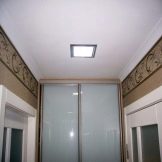
Two-tier
Such structures are a popular solution for decorating ceilings in hallways and give rooms a stylish look. Possessing a high decorative effect, such models are able to visually push apart the walls of narrow corridors. This can be achieved by combining arched and straight lines, which are selected taking into account the size of the hallway.
In addition, the thoughtful and carefully designed plasterboard overhangs above cabinets, hangers and shelving help to highlight the value of the furniture and draw attention to it.






Tiered
Such gypsum plasterboard ceiling systems look great in spacious hallways and halls, they can include three or more levels.Such designs are distinguished by a variety of geometric shapes and the ability to implement bold artistic ideas, however, due to too many elements, they are heavy, and in small spaces they look cumbersome. Besides, due to the multiple curvilinear combinations, only a specialist should mount such a ceiling.
It will be very difficult for a novice craftsman to perfectly fit the elements to each other, which can cause the parts to crack after installation.
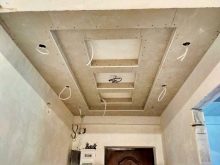

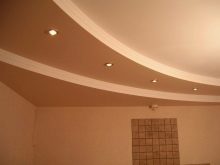
Combined
This option is a combination of plasterboard construction with a stretch ceiling. Thanks to the wide variety of PVC films, you can create real masterpieces on the ceiling. Plasterboard plates in such structures play the role of boxes or curly frames, and most of the decorative load falls on the tension canvas. With its help, you can get a reconstruction of the starry sky, saturate the room with bright shades of the rising sun. The combination of gypsum board with glass looks very impressive, where glass can be used in the form of transparent and matte inserts, a screen over which clouds will "run" or peep the tops of trees.
To do this, the side elements of the plasterboard structure, located above the glass, are pasted over with a decorative film with photo printing and are effectively illuminated from the inside.


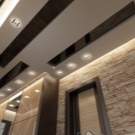



Design options
The design of plasterboard ceilings is chosen depending on the size and interior of the hallway. In tiny rooms, it is better to install a simple single-level ceiling. If the area allows you to hang a more interesting structure, then the design work should be started with a sketch. In the picture, you should display the desired background and see if it will be in harmony with the walls and furniture.
If a drawing is supposed to be applied to the ceiling, then for small hallways it should be made as simple as possible.
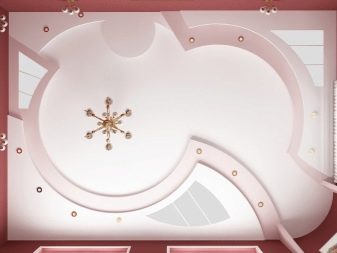

To visually increase the space, it is necessary to plan the lighting in such a way that it fills the corridor with light as much as possible, but at the same time does not hit the eyes. As for color solutions, then in small rooms it is better to use light shades, since dark colors will visually make the space even smaller.




When choosing a ceiling design for spacious hallways, you should take into account the general style of the room and the color combination. In such spaces, multi-level figured structures, combined with stretch canvases and glass, look good. The ceiling structure looks interesting with a version of the ceiling transition from the hall to the living room. Such models are designed in the same style, however, the geometry of the hallway ceiling may differ from the geometry in the hall.

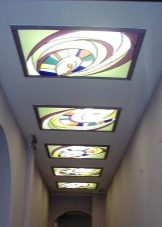


The decorative design of drywall and the choice of finishing coat completely depend on the style of the room. So, for Scandinavian style, country, Provence and minimalism Smooth light surfaces with few curved levels work well. V rustic and ecological styles drywall is complemented with beams imitating natural wood, and for classic directions use beautiful borders, embossing, baguettes and stucco moldings.


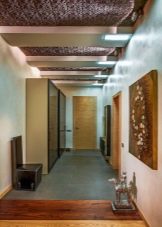

Lighting features
One of the main advantages of plasterboard ceiling structures is the ability to install built-in lamps. For this, a preliminary sketch is drawn, on which the number of lamps, their location and cable entry points are noted.
The most suitable options for drywall are LED and neon strips, which can visually "raise" the ceiling, if they are dispersed around the perimeter of the hallway. Flexible LED strips are used to form various inscriptions, curls and shapes.

Spotlights also look good on drywall systems. The most popular of these are LEDs, which do not irritate the eyes and gently diffuse light. In addition, they consume a minimum of electricity, have a long service life and are available in a wide range. Classic chandeliers combined with plasterboard ceilings are rare. This is due to their high weight and the risk of damaging the fragile plaster structure. In cases where the design requires the installation of chandeliers, they are tightly mounted to the main ceiling, and only then, taking into account their location, they build a gypsum board structure.
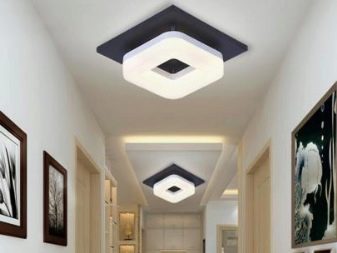



Beautiful examples
Plasterboard ceilings visibly transform the room and effectively emphasize the overall style of the hallway.
- A simple ceiling with original lighting looks very aesthetically pleasing and visually expands the space.

- The two-level plasterboard construction harmoniously repeats the wood texture of the doors and looks very noble.

- A multi-level GKL system is an excellent solution for spacious rooms.

- The successful combination of LED strip and spotlights will fill the hallway with light and give it a futuristic look.
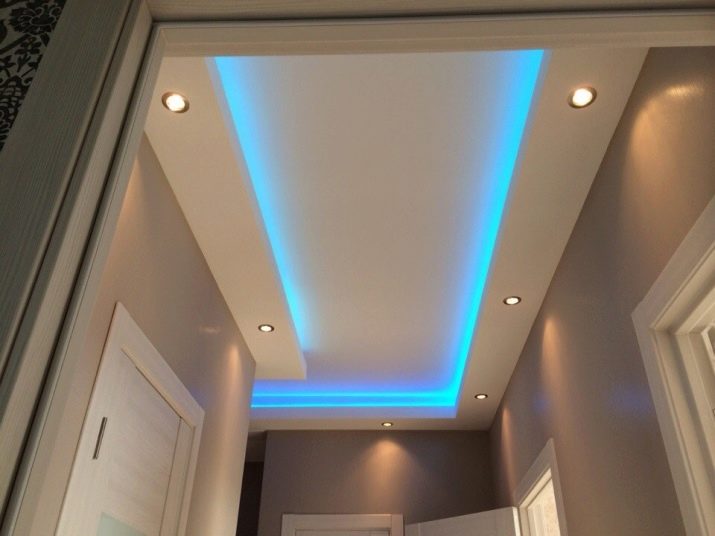
- The combined construction of plasterboard and stretch fabric will add a touch of luxury to even the simplest hallway.

About what is better drywall or stretch ceiling, see the next video.








